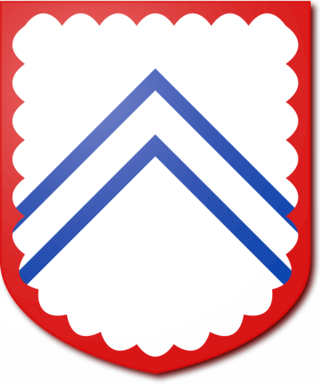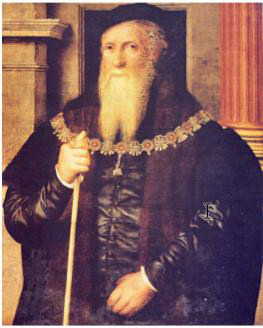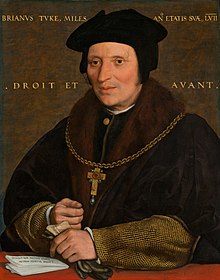A Postmaster General, in Anglosphere countries, is the chief executive officer of the postal service of that country, a ministerial office responsible for overseeing all other postmasters.

Charles Brandon, 1st Duke of Suffolk, 1st Viscount Lisle, was an English military leader and courtier. Through his third wife, Mary Tudor, he was brother-in-law to King Henry VIII.
Sir Samuel Argall was an English adventurer and naval officer.

Sir Edward Montagu of Boughton, Hanging Houghton and Hemington in Northamptonshire was an English lawyer and judge in the time of Henry VIII and Edward VI. He was Chief Justice of the King's Bench from 1539 to 1545 and Chief Justice of the Common Pleas from 1545 to 1553.

Nicholas Vaux, 1st Baron Vaux of Harrowden was a soldier and courtier in England and an early member of the House of Commons. He was the son of Lancastrian loyalists Sir William Vaux of Harrowden and Katherine Penyson, a lady of the household of Queen Margaret of Anjou, wife of the Lancastrian king, Henry VI of England. Katherine was a daughter of Gregorio Panizzone of Courticelle, in Piedmont, Italy which was at that time subject to King René of Anjou, father of Queen Margaret of Anjou, as ruler of Provence. He grew up during the years of Yorkist rule and later served under the founder of the Tudor dynasty, Henry VII.

Sir John Tyrrell, of Heron in the Essex parish of East Horndon, was an English landowner, lawyer, administrator, and politician who was chosen three times as Speaker of the House of Commons.

Sir Thomas Arundell of Wardour Castle in Wiltshire was a Cornish administrator and alleged conspirator.

John de Vere, 15th Earl of Oxford, Lord Great Chamberlain KGPC was an English peer and courtier.
Robert Radcliffe, 10th Baron Fitzwalter, 1st Earl of Sussex, KG, KB, PC, also spelt Radclyffe, Ratcliffe, Ratcliff, etc., was a prominent courtier and soldier during the reigns of Henry VII and Henry VIII, who served as Chamberlain of the Exchequer and Lord Great Chamberlain.
John de Vere, 14th Earl of Oxford was an English peer and landowner.
Sir Humphrey Wingfield was an English lawyer and Speaker of the House of Commons of England between 1533 and 1536.

Sir Anthony Wingfield KG, MP, of Letheringham, Suffolk, was an English soldier, politician, courtier and member of parliament. He was the Lord Lieutenant of Suffolk from 1551 to 1552, and Vice-Chamberlain of the Household in the reign of Edward VI.
Thomas Poynings, 1st Baron Poynings was an English soldier and courtier.

Sir Henry Wentworth of Nettlestead, Suffolk, KB, de jure 4th Baron le Despenser was an English baron who is notable for being the grandfather of Henry VIII's third wife, Jane Seymour, and the great-grandfather of Jane's son, Edward VI.

Richard Neville, 2nd Baron Latimer KB of Snape, North Yorkshire, was an English soldier and peer. He fought at the battles of Stoke and Flodden.

Sir John Scott was the eldest son of Sir William Scott of Scot's Hall. He served in King Henry VIII's campaigns in France and was active in local government in Kent and a Member of Parliament for New Romney. He was the grandfather of both Reginald Scott, author of The Discoverie of Witchcraft, a source for Shakespeare's Macbeth, and Thomas Keyes, who married Lady Mary Grey.
Sir Richard Jerningham was a soldier and diplomat in the service of King Henry VIII.
Sir William Browne served as Master of the Worshipful Company of Mercers from 1507 to 1514, and as alderman, auditor, Sheriff and Lord Mayor of London. He died in office on 3 June 1514 while serving his term as Lord Mayor.

Sir Edward Echyngham, , of Barsham and Ipswich in Suffolk, was a commander on land and at sea, briefly Constable of Limerick Castle, and Collector of Customs at Ipswich. He is remembered as the author of a letter to Cardinal Wolsey describing the death of Lord Admiral Howard at Brest in 1513. From 1485 the presence of the Howard Dukes of Norfolk was felt directly along the Barsham reach of the River Waveney from their possession of Bungay Castle.

Anne Say was an English Baroness through her marriage to Sir Henry Wentworth in c. 1470 until her death. She was the daughter of Sir John Say (1441–1483) and his wife Elizabeth Cheney, Lady Say. She is notable for being the maternal grandmother to Jane Seymour, the third wife of King Henry VIII of England, making her the great-grandmother to Edward VI.













